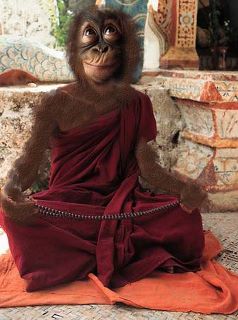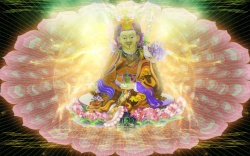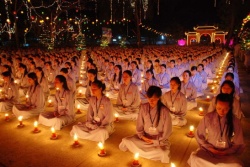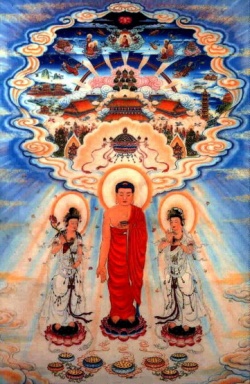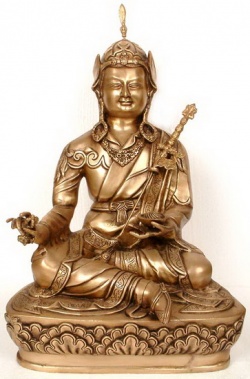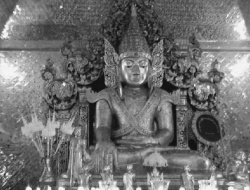Difference between revisions of "Aro gTér"
| Line 1: | Line 1: | ||
| + | {{SeealsoDPL/button}} | ||
<nomobile>{{DisplayImages|1772|4413|3223|1130|2077|3050}}</nomobile> | <nomobile>{{DisplayImages|1772|4413|3223|1130|2077|3050}}</nomobile> | ||
| Line 4: | Line 5: | ||
| − | Aro is a lineage within the Nyingma tradition of Tibetan Buddhism. It has several unusual characteristics. The terma on which it is based teaches all Buddhist topics from point of view of Dzogchen, and so is characterized by uncommon simplicity. The lineage is entirely non-monastic (Ngagpa), and so emphasizes householder practice and non-celibate ordination. All of its contemporary teachers are ethnically non-Tibetan. | + | [[Aro]] is a [[lineage]] within the [[Nyingma tradition]] of [[Tibetan Buddhism]]. It has several unusual [[characteristics]]. The [[terma]] on which it is based teaches all [[Buddhist]] topics from point of view of [[Dzogchen]], and so is characterized by uncommon [[simplicity]]. The [[lineage]] is entirely [[non-monastic]] ([[Ngagpa]]), and so emphasizes [[householder]] practice and non-celibate [[ordination]]. All of its contemporary [[teachers]] are ethnically non-Tibetan. |
| − | ==The terma== | + | ==The [[terma]]== |
| − | The Aro lineage is based on the Aro gTér, a terma or "revelation" of Khyungchen Aro Lingma. The Aro gTér has several distinctive characteristics: it treats all Buddhist subjects from point of view of Dzogchen; as a consequence its practices are simpler than the elaborate sadhanas typical of Tantric Buddhism; and it includes practices of semde and longde as well as the more common men-ngag-de. These characteristics make it particularly suitable for those with jobs and families, and therefore limited practice time, which accords with the Aro lineage's non-monastic orientation. | + | The [[Aro]] [[lineage]] is based on the [[Aro gTér]], a [[terma]] or "[[revelation]]" of [[Khyungchen Aro Lingma]]. The [[Aro gTér]] has several {{Wiki|distinctive}} [[characteristics]]: it treats all [[Buddhist]] [[subjects]] from point of view of [[Dzogchen]]; as a consequence its practices are simpler than the elaborate [[sadhanas]] typical of [[Tantric Buddhism]]; and it includes practices of [[semde]] and [[longde]] as well as the more common men-ngag-de. These [[characteristics]] make it particularly suitable for those with jobs and families, and therefore limited practice time, which accords with the [[Aro]] [[lineage's]] [[non-monastic]] orientation. |
| − | === Pervasive Dzogchen approach === | + | === Pervasive [[Dzogchen]] approach === |
| − | Dzogchen is the Buddhist yana (approach) that takes one's own intrinsic enlightened nature as the basis of practice. From the point of view of Dzogchen, all beings are always already enlightened. The goal of Tibetan Buddhist practice is to recognize and manifest that pre-existing enlightenment as a Bodhisattva in benefiting others. There is, therefore, nothing that needs to be created or removed, and no special conditions are required. The only difference between ordinary existence and Buddhahood is in the way experience is perceived: as dualistic or non-dual. | + | [[Dzogchen]] is the [[Buddhist]] [[yana]] (approach) that takes one's [[own]] intrinsic [[enlightened nature]] as the basis of practice. From the point of view of [[Dzogchen]], all [[beings]] are always already [[enlightened]]. The goal of [[Tibetan Buddhist]] practice is to [[recognize]] and [[manifest]] that pre-existing [[enlightenment]] as a [[Bodhisattva]] in [[benefiting others]]. There is, therefore, nothing that needs to be created or removed, and no special [[conditions]] are required. The only difference between ordinary [[existence]] and [[Buddhahood]] is in the way [[experience]] is [[perceived]]: as [[dualistic]] or [[non-dual]]. |
| − | The Dzogchen point of view permeates Aro. The lower yanas (Sutrayana and Tantrayana) are re-presented in Dzogchen terms, and take on its characteristic style of simplicity, clarity, and expansiveness. Enlightenment needs only to be recognized, and is not produced by artificial means. Aro is therefore primarily concerned with bringing meditative awareness into ordinary life, rather than with elaborate, intellectualized, and time-consuming liturgical chanting. For Dzogchen, the ultimate practice is "living the view," i. e. experiencing and acting in the world as non-dual. | + | The [[Dzogchen]] point of view permeates [[Aro]]. The lower [[yanas]] ([[Sutrayana]] and [[Tantrayana]]) are re-presented in [[Dzogchen]] terms, and take on its [[characteristic]] style of [[simplicity]], clarity, and expansiveness. [[Enlightenment]] needs only to be [[recognized]], and is not produced by artificial means. [[Aro]] is therefore primarily concerned with bringing [[meditative awareness]] into ordinary [[life]], rather than with elaborate, intellectualized, and time-consuming liturgical [[chanting]]. For [[Dzogchen]], the [[Wikipedia:Absolute (philosophy)|ultimate]] practice is "living the view," i. e. experiencing and acting in the [[world]] as [[non-dual]]. |
[[File:Tmp932_thumb_2.jpg|thumb|250px|]] | [[File:Tmp932_thumb_2.jpg|thumb|250px|]] | ||
| − | === The Heart Sutra and the Sutra of the Owl-Headed Dakini === | + | === The [[Heart Sutra]] and the [[Sutra]] of the Owl-Headed [[Dakini]] === |
| − | As in Dzogchen generally, understanding of the relationships between form, emptiness, and non-duality is central to Aro. Unusually, Aro takes the Heart Sutra (conventionally part of Mahayana rather than Dzogchen) as the central text on this topic. The Heart Sutra's statement that "form is emptiness and emptiness is form" is regarded as the essence of the matter. | + | As in [[Dzogchen]] generally, [[understanding]] of the relationships between [[form]], [[emptiness]], and [[non-duality]] is central to [[Aro]]. Unusually, [[Aro]] takes the [[Heart Sutra]] ({{Wiki|conventionally}} part of [[Mahayana]] rather than [[Dzogchen]]) as the central text on this topic. The [[Heart]] [[Sutra's]] statement that "[[form]] is [[emptiness]] and [[emptiness]] is [[form]]" is regarded as the [[essence]] of the {{Wiki|matter}}. |
| − | Within the Aro gTér, the Sutra of the Owl-Headed Dakini (Wylie: 'ug gdong snying thig mkha' 'gro mdo; Sanskrit: Ulukha-mukha Dakini Upadesha Sutra) treats the major topics of Sutrayana from point of view of Dzogchen. It includes unusual presentations of the Four Noble Truths and Eightfold Path, and of the Five Precepts. The Five Precepts are said to have inner meanings at the level of Dzogchen, as follows: | + | Within the [[Aro gTér]], the [[Sutra]] of the Owl-Headed [[Dakini]] ([[Wylie]]: 'ug gdong [[snying thig]] [[mkha' 'gro]] mdo; [[Sanskrit]]: Ulukha-mukha [[Dakini]] [[Upadesha]] [[Sutra]]) treats the major topics of [[Sutrayana]] from point of view of [[Dzogchen]]. It includes unusual presentations of the [[Four Noble Truths]] and [[Eightfold Path]], and of the [[Five Precepts]]. The [[Five Precepts]] are said to have inner meanings at the level of [[Dzogchen]], as follows: |
{| class="wikitable" | {| class="wikitable" | ||
|- | |- | ||
| − | ! Sutrayana presentation | + | ! [[Sutrayana]] presentation |
| − | ! Aro presentation | + | ! [[Aro]] presentation |
|- | |- | ||
| − | | To refrain from killing sentient beings. | + | | To refrain from {{Wiki|killing}} [[sentient beings]]. |
| − | | To refrain from killing the efflorescence of rigpa as it sparkles through the fabric of duality. | + | | To refrain from {{Wiki|killing}} the efflorescence of [[rigpa]] as it sparkles through the fabric of [[duality]]. |
|- | |- | ||
| − | | To refrain from stealing. | + | | To refrain from [[stealing]]. |
| − | | To refrain from stealing opportunities for realization. | + | | To refrain from [[stealing]] opportunities for [[realization]]. |
|- | |- | ||
| − | | To refrain from sexual misconduct. | + | | To refrain from [[sexual misconduct]]. |
| − | | To remain always in ecstatic embrace with the [[dakini|khandro]] or pawo. | + | | To remain always in {{Wiki|ecstatic}} embrace with the [[dakini|khandro]] or [[pawo]]. |
|- | |- | ||
| − | | To refrain from lying. | + | | To refrain from {{Wiki|lying}}. |
| − | | To refrain from expressing the lie of dualism. | + | | To refrain from expressing the lie of [[dualism]]. |
|- | |- | ||
| − | | To refrain from intoxicants. | + | | To refrain from [[intoxicants]]. |
| − | | To refrain from the intoxication of duality, and to become drunken with primordial wisdom. | + | | To refrain from the [[intoxication]] of [[duality]], and to become drunken with [[primordial wisdom]]. |
|} | |} | ||
| − | === Essential Tantric practice === | + | === [[Essential]] [[Tantric practice]] === |
| − | Dzogchen practices are typically much simpler than those of Tantra. Aro describes its Tantric practices as "essential," meaning that they lack the typical complexities of Tantra (elaborate mandala visualizations, extensive sadhana texts, and lengthy rituals). This is viewed as a reflection of the simple style of the Indian Mahasiddhas in the earliest days of Tantra. | + | [[Dzogchen]] practices are typically much simpler than those of [[Tantra]]. [[Aro]] describes its [[Tantric practices]] as "[[essential]]," meaning that they lack the typical complexities of [[Tantra]] (elaborate [[mandala]] [[visualizations]], extensive [[sadhana]] texts, and lengthy [[rituals]]). This is viewed as a {{Wiki|reflection}} of the simple style of the [[Indian]] [[Mahasiddhas]] in the earliest days of [[Tantra]]. |
| − | In terms of the two Inner Tantras not counting Dzogchen, Aro is concerned primarily with Anuyoga, emphasizing tsa lung and completion practice rather than with Mahayoga, which emphasizes ritual performance and generation practice. As in the Anuyoga style generally, yidams are practiced without a textual sadhana, but simply by self-arising with mantra. The practice of lhatong, from the semde ngöndro (see below), is also viewed as encompassing Tantra, so that accomplishing lhatong has the same value as accomplishing Tantric sadhana. | + | In terms of the two [[Inner Tantras]] not counting [[Dzogchen]], [[Aro]] is concerned primarily with [[Anuyoga]], {{Wiki|emphasizing}} [[tsa lung]] and completion practice rather than with [[Mahayoga]], which emphasizes [[ritual]] performance and generation practice. As in the [[Anuyoga]] style generally, [[yidams]] are practiced without a textual [[sadhana]], but simply by [[self-arising]] with [[mantra]]. The practice of lhatong, from the [[semde]] [[ngöndro]] (see below), is also viewed as encompassing [[Tantra]], so that accomplishing lhatong has the same value as accomplishing [[Tantric]] [[sadhana]]. |
| − | Aro emphasizes "yogic song," a mainly Dzogchen practice. Yogic songs are short texts (such as mantras) set to melodies, and sung repeatedly. | + | [[Aro]] emphasizes "[[yogic song]]," a mainly [[Dzogchen practice]]. [[Yogic]] [[songs]] are short texts (such as [[mantras]]) set to melodies, and sung repeatedly. |
| − | === Emotions and Trekchöd === | + | === [[Emotions]] and [[Trekchöd]] === |
| − | Aro teaches the Dzogchen system of the five elemental neuroses (territoriality, aggression, neediness, anxiety, and depression) and five corresponding wisdoms (generosity, clarity, compassionate appreciation, accomplishment, and unboundedness). It teaches both Tantric methods of transforming the neuroses into wisdoms and the Dzogchen trekchöd method of liberating neuroses into their natural condition. | + | [[Aro]] teaches the [[Dzogchen]] system of the five [[elemental]] neuroses (territoriality, [[aggression]], neediness, [[anxiety]], and {{Wiki|depression}}) and five corresponding [[wisdoms]] ([[generosity]], clarity, [[compassionate]] [[appreciation]], [[accomplishment]], and unboundedness). It teaches both [[Tantric]] methods of [[transforming]] the neuroses into [[wisdoms]] and the [[Dzogchen]] [[trekchöd]] method of liberating neuroses into their natural [[condition]]. |
| − | === Semde === | + | === [[Semde]] === |
| − | Dzogchen encompasses three "series," or approaches: semde, longde, and men-ngag-de. Historically all three were important, but in recent centuries men-ngag-de has largely displaced the other two, as it is considered more advanced. Men-ngag-de is also, however, the least approachable in its own terms, and typically therefore Dzogchen has been made available only to those who have mastered Tantra. Aro includes material in all three series. | + | [[Dzogchen]] encompasses three "series," or approaches: [[semde]], [[longde]], and men-ngag-de. Historically all three were important, but in recent centuries men-ngag-de has largely displaced the other two, as it is considered more advanced. Men-ngag-de is also, however, the least approachable in its [[own]] terms, and typically therefore [[Dzogchen]] has been made available only to those who have mastered [[Tantra]]. [[Aro]] includes material in all three series. |
| − | Semde, the Series of the Nature of Mind, is the most approachable series, because it contains a ngöndro or "preparation" consisting of four meditation practices that bring the student to level of experience required to practice Dzogchen proper. These are shi-nè, lhatong, nyi-mèd, and lhundrüp. Shi-nè ("calm abiding") is the meditation practice that leads to the experience of emptiness, and corresponds to Sutrayana. Lhatong ("further vision") leads to the experience of form arising from emptiness, and corresponds to Tantrayana. Nyi-mèd ("non-duality") produces the recognition of the sameness of emptiness and form. Lhundrüp ("spontaneity") is the experience of enlightenment itself. | + | [[Semde]], the Series of the [[Nature of Mind]], is the most approachable series, because it contains a [[ngöndro]] or "preparation" consisting of four [[meditation practices]] that bring the [[student]] to level of [[experience]] required to practice [[Dzogchen]] proper. These are [[shi-nè]], lhatong, nyi-mèd, and lhundrüp. [[Shi-nè]] ("[[calm abiding]]") is the [[meditation practice]] that leads to the [[experience]] of [[emptiness]], and corresponds to [[Sutrayana]]. Lhatong ("further [[vision]]") leads to the [[experience]] of [[form]] [[arising]] from [[emptiness]], and corresponds to [[Tantrayana]]. Nyi-mèd ("[[non-duality]]") produces the {{Wiki|recognition}} of the [[sameness]] of [[emptiness]] and [[form]]. Lhundrüp ("spontaneity") is the [[experience of enlightenment]] itself. |
| − | === Longde and sKu-mNyé === | + | === [[Longde]] and [[sKu-mNyé]] === |
| − | Longde, the Series of Space, is concerned primarily with the experience of the tsa lung system or "energetic body." It contains various systems of physical exercises that produce unusual sensations in which the practitioner may find rigpa. Aro sKu-mNyé is one such. | + | [[Longde]], the Series of [[Space]], is concerned primarily with the [[experience]] of the [[tsa lung]] system or "energetic [[body]]." It contains various systems of [[physical]] exercises that produce unusual [[sensations]] in which the [[practitioner]] may find [[rigpa]]. [[Aro]] [[sKu-mNyé]] is one such. |
| − | Aro sKu-mNyé is a set of 111 exercises divided into six series, the movements of the lion, the vulture, the tiger, the eagle, the garuda, and the dragon. They range from simple and gentle to vigorous and extremely difficult. They disorient the conceptual mind and galvanize the body's subtle energies, in order to give access to non-ordinary experience. The system is also taught as a general exercise regimen to non-Buddhists, and for other non-religious benefits, rather as hatha yoga is. | + | [[Aro]] [[sKu-mNyé]] is a set of 111 exercises divided into six series, the movements of the [[lion]], the [[vulture]], the [[tiger]], the {{Wiki|eagle}}, the [[garuda]], and the [[dragon]]. They range from simple and gentle to vigorous and extremely difficult. They disorient the [[conceptual mind]] and galvanize the [[body's]] {{Wiki|subtle}} energies, in order to give access to non-ordinary [[experience]]. The system is also [[taught]] as a general exercise regimen to non-Buddhists, and for other non-religious benefits, rather as [[hatha yoga]] is. |
| − | === Romance as Buddhist practice === | + | === Romance as [[Buddhist practice]] === |
| − | One of the Tantric samaya (vows) is for men always to regard women as the embodiment of wisdom and never to disparage them. Aro, with a predominance of female practitioners, makes the symmetry explicit: women vow to regard men as the embodiment of compassion and never to disparage them. The Aro Tantra of the Mirror that Reflects the Sun and Moon of the Khandros and Pawos discusses the consequences of this Tantric vow from point of view of men-ngag-de. It describes perceptual practices that are possible only within the context of romantic relationship. | + | One of the [[Tantric]] [[samaya]] ([[vows]]) is for men always to regard women as the [[embodiment of wisdom]] and never to disparage them. [[Aro]], with a predominance of {{Wiki|female}} practitioners, makes the {{Wiki|symmetry}} explicit: women [[vow]] to regard men as the [[embodiment]] of [[compassion]] and never to disparage them. The [[Aro]] [[Tantra]] of the [[Mirror]] that Reflects the {{Wiki|Sun}} and [[Moon]] of the [[Khandros]] and [[Pawos]] discusses the {{Wiki|consequences}} of this [[Tantric]] [[vow]] from point of view of men-ngag-de. It describes {{Wiki|perceptual}} practices that are possible only within the context of romantic relationship. |
| − | Aro is explicitly gay-friendly, although not all of its teachings on romance are applicable to same-sex relationships. | + | [[Aro]] is explicitly gay-friendly, although not all of its teachings on romance are applicable to same-sex relationships. |
| − | === The name "Aro gTér" === | + | === The [[name]] "[[Aro gTér]]" === |
| − | Aro means "taste of the primordial A" in Tibetan; this letter has special significance as a seed syllable in Vajrayana Buddhism. gTér is a spelling of terma (Wylie: gter ma). The Aro gTér is not known to have any connection with the much earlier Aro system of Dzogchen semde promulgated by Aro Yeshé Jungné. | + | [[Aro]] means "{{Wiki|taste}} of the [[primordial]] A" in [[Tibetan]]; this [[letter]] has special significance as a [[seed syllable]] in [[Vajrayana Buddhism]]. [[gTér]] is a spelling of [[terma]] ([[Wylie]]: [[gter ma]]). The [[Aro gTér]] is not known to have any connection with the much earlier [[Aro]] system of [[Dzogchen]] [[semde]] promulgated by [[Aro]] [[Yeshé]] Jungné. |
| − | ==Lineage history== | + | ==[[Lineage]] history== |
| − | According to the terma, Aro has antecedents in a "Mother Essence Lineage" of female tertöns stretching back to Yeshe Tsogyal, in the early days of Buddhism in Tibet, and forward to Aro Lingma (1886-1923), who discovered it. | + | According to the [[terma]], [[Aro]] has antecedents in a "[[Mother Essence Lineage]]" of {{Wiki|female}} [[tertöns]] stretching back to [[Yeshe Tsogyal]], in the early days of [[Buddhism in Tibet]], and forward to [[Aro Lingma]] (1886-1923), who discovered it. |
| − | Aro Lingma, also sometimes called Jetsunma Khandro Yeshe Rema, is said to have transmitted the lineage to her only son, named Aro Yeshe (1915-1951). One of the present Aro gTér lineage holders, Ngak'chang Rinpoche, was recognized as the tulku of Aro Yeshe by Dilgo Khyentse Rinpoche, and as the incarnation of Aro Yeshe's predecessor, 'a-Shul Pema Legden, by Khordong gTerchen Tulku Chhi'med Rig'dzin Rinpoche. In the 1970s, Ngak'chang Rinpoche studied with Chhi'med Rig'dzin Rinpoche, Dudjom Rinpoche, Dilgo Khyentse Rinpoche, Kunzang Dorje Rinpoche, Khamtrül Yeshé Dorje Rinpoche and Konchog Rinpoche. Ngak'chang Rinpoche has written of his experiences of these times in his 2011 book Wisdom Eccentrics. | + | [[Aro Lingma]], also sometimes called [[Jetsunma]] [[Khandro]] Yeshe Rema, is said to have transmitted the [[lineage]] to her only son, named [[Aro Yeshe]] (1915-1951). One of the {{Wiki|present}} [[Aro gTér]] [[lineage holders]], [[Ngak'chang Rinpoche]], was [[recognized]] as the [[tulku]] of [[Aro Yeshe]] by [[Dilgo Khyentse Rinpoche]], and as the [[incarnation]] of [[Aro]] Yeshe's predecessor, [['a-Shul Pema Legden]], by Khordong gTerchen [[Tulku]] Chhi'med Rig'dzin [[Rinpoche]]. In the 1970s, [[Ngak'chang Rinpoche]] studied with Chhi'med Rig'dzin [[Rinpoche]], [[Dudjom Rinpoche]], [[Dilgo Khyentse Rinpoche]], [[Kunzang Dorje Rinpoche]], [[Khamtrül Yeshé Dorje Rinpoche]] and [[Konchog]] [[Rinpoche]]. [[Ngak'chang Rinpoche]] has written of his [[experiences]] of these times in his 2011 [[book]] [[Wisdom]] Eccentrics. |
| − | ==Aro in the contemporary West== | + | ==[[Aro]] in the contemporary [[West]]== |
| − | The current Aro lineage holders, Ngak'chang Rinpoche and Khandro Déchen, are ethnically non-Tibetan. Other Lamas of the lineage were also Western-born, and teach in the United States and various European countries. The lineage's primary legal organization, given the name Sang-ngak-chö-dzong by Dudjom Rinpoche, is located in Britain. | + | The current [[Aro]] [[lineage holders]], [[Ngak'chang Rinpoche]] and [[Khandro Déchen]], are ethnically non-Tibetan. Other [[Lamas]] of the [[lineage]] were also Western-born, and teach in the [[Wikipedia:United States of America (USA)|United States]] and various {{Wiki|European}} countries. The [[lineage's]] primary legal [[organization]], given the [[name]] [[Sang-ngak-chö-dzong]] by [[Dudjom Rinpoche]], is located in {{Wiki|Britain}}. |
| − | In Tibet, Aro was a non-monastic lineage, practiced by lay people and by holders of Ngak'phang (non-monastic, non-celibate) ordination. Its modern structure reflects continuing commitment to these two groups. | + | In [[Tibet]], [[Aro]] was a [[non-monastic]] [[lineage]], practiced by [[lay people]] and by holders of [[Ngak'phang]] ([[non-monastic]], non-celibate) [[ordination]]. Its {{Wiki|modern}} {{Wiki|structure}} reflects continuing commitment to these two groups. |
| − | Aro strongly upholds the centrality of the Lama-student relationship in Vajrayana. Aro Lamas typically teach as married couples. | + | [[Aro]] strongly upholds the centrality of the Lama-student relationship in [[Vajrayana]]. [[Aro]] [[Lamas]] typically teach as [[married]] couples. |
=== Apprenticeship === | === Apprenticeship === | ||
| − | A journal article describes the evolution of the Aro "apprenticeship" program, an institutional form not found in Tibet. It was designed to make extensive interaction with Lamas possible for people with families – more than is typically possible either in Tibet or with Tibetan Lamas in the West. | + | A journal article describes the [[evolution]] of the [[Aro]] "apprenticeship" program, an institutional [[form]] not found in [[Tibet]]. It was designed to make extensive interaction with [[Lamas]] possible for [[people]] with families – more than is typically possible either in [[Tibet]] or with [[Tibetan]] [[Lamas]] in the [[West]]. |
| − | Apprenticeship is an intermediate stage between typical householder religious adherence and ordination. For serious students, it provides the frequent personal guidance from Lamas that is generally unavailable to non-ordained people. On the other hand, it does not require Tantric samaya or the Ngak'phang commitments. | + | Apprenticeship is an [[intermediate stage]] between typical [[householder]] [[religious]] adherence and [[ordination]]. For serious students, it provides the frequent personal guidance from [[Lamas]] that is generally unavailable to non-ordained [[people]]. On the other hand, it does not require [[Tantric]] [[samaya]] or the [[Ngak'phang]] [[commitments]]. |
| − | To ensure that close relationships with Lamas remain possible, Aro adopted limits on the number of students any Lama teaches. It has a "lateral" mode of growth, "with a greater number of teachers, rather than one teacher with an unwieldy number of students." | + | To ensure that close relationships with [[Lamas]] remain possible, [[Aro]] adopted limits on the number of students any [[Lama]] teaches. It has a "lateral" mode of growth, "with a greater number of [[teachers]], rather than one [[teacher]] with an unwieldy number of students." |
| − | === Ordination === | + | === [[Ordination]] === |
| − | Tibetan Buddhism contains two systems of ordination, the familiar monastic ordinations and the less well known Ngak'phang or Tantric ordinations. Ngak'phang ordination is non-monastic and non-celibate, but not "lay." It entails its own extensive system of vows, distinct from the monastic vows. | + | [[Tibetan Buddhism]] contains two systems of [[ordination]], the familiar [[monastic]] [[ordinations]] and the less well known [[Ngak'phang]] or [[Tantric]] [[ordinations]]. [[Ngak'phang]] [[ordination]] is [[non-monastic]] and non-celibate, but not "lay." It entails its [[own]] extensive system of [[vows]], {{Wiki|distinct}} from the [[monastic vows]]. |
{{W}} | {{W}} | ||
[[Category:Nyingma lineage]] | [[Category:Nyingma lineage]] | ||
Revision as of 14:14, 16 December 2015
Click here to see other articles relating to word Aro gTér
Aro is a lineage within the Nyingma tradition of Tibetan Buddhism. It has several unusual characteristics. The terma on which it is based teaches all Buddhist topics from point of view of Dzogchen, and so is characterized by uncommon simplicity. The lineage is entirely non-monastic (Ngagpa), and so emphasizes householder practice and non-celibate ordination. All of its contemporary teachers are ethnically non-Tibetan.
The terma
The Aro lineage is based on the Aro gTér, a terma or "revelation" of Khyungchen Aro Lingma. The Aro gTér has several distinctive characteristics: it treats all Buddhist subjects from point of view of Dzogchen; as a consequence its practices are simpler than the elaborate sadhanas typical of Tantric Buddhism; and it includes practices of semde and longde as well as the more common men-ngag-de. These characteristics make it particularly suitable for those with jobs and families, and therefore limited practice time, which accords with the Aro lineage's non-monastic orientation.
Pervasive Dzogchen approach
Dzogchen is the Buddhist yana (approach) that takes one's own intrinsic enlightened nature as the basis of practice. From the point of view of Dzogchen, all beings are always already enlightened. The goal of Tibetan Buddhist practice is to recognize and manifest that pre-existing enlightenment as a Bodhisattva in benefiting others. There is, therefore, nothing that needs to be created or removed, and no special conditions are required. The only difference between ordinary existence and Buddhahood is in the way experience is perceived: as dualistic or non-dual.
The Dzogchen point of view permeates Aro. The lower yanas (Sutrayana and Tantrayana) are re-presented in Dzogchen terms, and take on its characteristic style of simplicity, clarity, and expansiveness. Enlightenment needs only to be recognized, and is not produced by artificial means. Aro is therefore primarily concerned with bringing meditative awareness into ordinary life, rather than with elaborate, intellectualized, and time-consuming liturgical chanting. For Dzogchen, the ultimate practice is "living the view," i. e. experiencing and acting in the world as non-dual.
The Heart Sutra and the Sutra of the Owl-Headed Dakini
As in Dzogchen generally, understanding of the relationships between form, emptiness, and non-duality is central to Aro. Unusually, Aro takes the Heart Sutra (conventionally part of Mahayana rather than Dzogchen) as the central text on this topic. The Heart Sutra's statement that "form is emptiness and emptiness is form" is regarded as the essence of the matter.
Within the Aro gTér, the Sutra of the Owl-Headed Dakini (Wylie: 'ug gdong snying thig mkha' 'gro mdo; Sanskrit: Ulukha-mukha Dakini Upadesha Sutra) treats the major topics of Sutrayana from point of view of Dzogchen. It includes unusual presentations of the Four Noble Truths and Eightfold Path, and of the Five Precepts. The Five Precepts are said to have inner meanings at the level of Dzogchen, as follows:
| Sutrayana presentation | Aro presentation |
|---|---|
| To refrain from killing sentient beings. | To refrain from killing the efflorescence of rigpa as it sparkles through the fabric of duality. |
| To refrain from stealing. | To refrain from stealing opportunities for realization. |
| To refrain from sexual misconduct. | To remain always in ecstatic embrace with the khandro or pawo. |
| To refrain from lying. | To refrain from expressing the lie of dualism. |
| To refrain from intoxicants. | To refrain from the intoxication of duality, and to become drunken with primordial wisdom. |
Essential Tantric practice
Dzogchen practices are typically much simpler than those of Tantra. Aro describes its Tantric practices as "essential," meaning that they lack the typical complexities of Tantra (elaborate mandala visualizations, extensive sadhana texts, and lengthy rituals). This is viewed as a reflection of the simple style of the Indian Mahasiddhas in the earliest days of Tantra.
In terms of the two Inner Tantras not counting Dzogchen, Aro is concerned primarily with Anuyoga, emphasizing tsa lung and completion practice rather than with Mahayoga, which emphasizes ritual performance and generation practice. As in the Anuyoga style generally, yidams are practiced without a textual sadhana, but simply by self-arising with mantra. The practice of lhatong, from the semde ngöndro (see below), is also viewed as encompassing Tantra, so that accomplishing lhatong has the same value as accomplishing Tantric sadhana.
Aro emphasizes "yogic song," a mainly Dzogchen practice. Yogic songs are short texts (such as mantras) set to melodies, and sung repeatedly.
Emotions and Trekchöd
Aro teaches the Dzogchen system of the five elemental neuroses (territoriality, aggression, neediness, anxiety, and depression) and five corresponding wisdoms (generosity, clarity, compassionate appreciation, accomplishment, and unboundedness). It teaches both Tantric methods of transforming the neuroses into wisdoms and the Dzogchen trekchöd method of liberating neuroses into their natural condition.
Semde
Dzogchen encompasses three "series," or approaches: semde, longde, and men-ngag-de. Historically all three were important, but in recent centuries men-ngag-de has largely displaced the other two, as it is considered more advanced. Men-ngag-de is also, however, the least approachable in its own terms, and typically therefore Dzogchen has been made available only to those who have mastered Tantra. Aro includes material in all three series.
Semde, the Series of the Nature of Mind, is the most approachable series, because it contains a ngöndro or "preparation" consisting of four meditation practices that bring the student to level of experience required to practice Dzogchen proper. These are shi-nè, lhatong, nyi-mèd, and lhundrüp. Shi-nè ("calm abiding") is the meditation practice that leads to the experience of emptiness, and corresponds to Sutrayana. Lhatong ("further vision") leads to the experience of form arising from emptiness, and corresponds to Tantrayana. Nyi-mèd ("non-duality") produces the recognition of the sameness of emptiness and form. Lhundrüp ("spontaneity") is the experience of enlightenment itself.
Longde and sKu-mNyé
Longde, the Series of Space, is concerned primarily with the experience of the tsa lung system or "energetic body." It contains various systems of physical exercises that produce unusual sensations in which the practitioner may find rigpa. Aro sKu-mNyé is one such.
Aro sKu-mNyé is a set of 111 exercises divided into six series, the movements of the lion, the vulture, the tiger, the eagle, the garuda, and the dragon. They range from simple and gentle to vigorous and extremely difficult. They disorient the conceptual mind and galvanize the body's subtle energies, in order to give access to non-ordinary experience. The system is also taught as a general exercise regimen to non-Buddhists, and for other non-religious benefits, rather as hatha yoga is.
Romance as Buddhist practice
One of the Tantric samaya (vows) is for men always to regard women as the embodiment of wisdom and never to disparage them. Aro, with a predominance of female practitioners, makes the symmetry explicit: women vow to regard men as the embodiment of compassion and never to disparage them. The Aro Tantra of the Mirror that Reflects the Sun and Moon of the Khandros and Pawos discusses the consequences of this Tantric vow from point of view of men-ngag-de. It describes perceptual practices that are possible only within the context of romantic relationship.
Aro is explicitly gay-friendly, although not all of its teachings on romance are applicable to same-sex relationships.
The name "Aro gTér"
Aro means "taste of the primordial A" in Tibetan; this letter has special significance as a seed syllable in Vajrayana Buddhism. gTér is a spelling of terma (Wylie: gter ma). The Aro gTér is not known to have any connection with the much earlier Aro system of Dzogchen semde promulgated by Aro Yeshé Jungné.
Lineage history
According to the terma, Aro has antecedents in a "Mother Essence Lineage" of female tertöns stretching back to Yeshe Tsogyal, in the early days of Buddhism in Tibet, and forward to Aro Lingma (1886-1923), who discovered it.
Aro Lingma, also sometimes called Jetsunma Khandro Yeshe Rema, is said to have transmitted the lineage to her only son, named Aro Yeshe (1915-1951). One of the present Aro gTér lineage holders, Ngak'chang Rinpoche, was recognized as the tulku of Aro Yeshe by Dilgo Khyentse Rinpoche, and as the incarnation of Aro Yeshe's predecessor, 'a-Shul Pema Legden, by Khordong gTerchen Tulku Chhi'med Rig'dzin Rinpoche. In the 1970s, Ngak'chang Rinpoche studied with Chhi'med Rig'dzin Rinpoche, Dudjom Rinpoche, Dilgo Khyentse Rinpoche, Kunzang Dorje Rinpoche, Khamtrül Yeshé Dorje Rinpoche and Konchog Rinpoche. Ngak'chang Rinpoche has written of his experiences of these times in his 2011 book Wisdom Eccentrics.
Aro in the contemporary West
The current Aro lineage holders, Ngak'chang Rinpoche and Khandro Déchen, are ethnically non-Tibetan. Other Lamas of the lineage were also Western-born, and teach in the United States and various European countries. The lineage's primary legal organization, given the name Sang-ngak-chö-dzong by Dudjom Rinpoche, is located in Britain.
In Tibet, Aro was a non-monastic lineage, practiced by lay people and by holders of Ngak'phang (non-monastic, non-celibate) ordination. Its modern structure reflects continuing commitment to these two groups.
Aro strongly upholds the centrality of the Lama-student relationship in Vajrayana. Aro Lamas typically teach as married couples.
Apprenticeship
A journal article describes the evolution of the Aro "apprenticeship" program, an institutional form not found in Tibet. It was designed to make extensive interaction with Lamas possible for people with families – more than is typically possible either in Tibet or with Tibetan Lamas in the West.
Apprenticeship is an intermediate stage between typical householder religious adherence and ordination. For serious students, it provides the frequent personal guidance from Lamas that is generally unavailable to non-ordained people. On the other hand, it does not require Tantric samaya or the Ngak'phang commitments.
To ensure that close relationships with Lamas remain possible, Aro adopted limits on the number of students any Lama teaches. It has a "lateral" mode of growth, "with a greater number of teachers, rather than one teacher with an unwieldy number of students."
Ordination
Tibetan Buddhism contains two systems of ordination, the familiar monastic ordinations and the less well known Ngak'phang or Tantric ordinations. Ngak'phang ordination is non-monastic and non-celibate, but not "lay." It entails its own extensive system of vows, distinct from the monastic vows.
